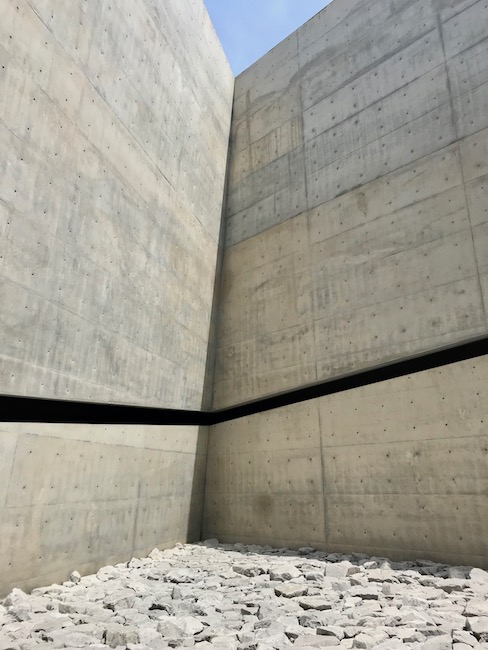Three trains and one ferry ride later we found ourselves riding electric bicycles on a small island called Naoshima in the Inland Seto Sea. The route from the port to our beachfront Mongolian yurt wound us over a quiet, hilly road filled with birdsong and sweet smelling trees. Toto, we are not in Kyoto anymore.
Naoshima can better be described through photos than through words. Which is what I will try to do here, except to say if you like art, architecture and quiet, magical places, please add this to your trip to Japan. Like much of the Japanese countryside, the islands of the Inland Seto Sea are a rough mix of industry and natural beauty. One half of the island is a Mitsubishi metal processing plant, and the other half is made up of two small fishing villages. The town was in steady decline until art collector and visionary Soichiro Fukutake, of Benesse holdings, bought a large hunk of land and brought in world famous architect Tadao Ando to design museums and lodging. The result is truly other worldly, and has transformed the sleepy island into a welcoming and fascinating destination.
We visited the Benesse House Museum early in the morning as soon as they opened, and had the place to ourselves. This museum would be an inspiring place to visit even if it were emptied of its art; the architectural design is that good. Next we went to the Chichu Art Museum, which contains only four exhibits (one of them being the building itself). We weren't so lucky with the crowds here, but it was still incredible. The entire museum is built underground and the exhibits are lit exclusively with natural light. Lest you forget that you are in Japan, two exhibits require you to take your shoes off and wear special slippers to enter.
Then there are the Art House Projects - abandoned 75-150 year old houses bought by Benesse holdings and turned over to artists to create permanent art installations. A map leads you through narrow streets of the small village to find all seven, each as different as the next. The photo above is Tatsuo Miyajima's Sea of Time '98, built inside of a 200 year old home. As described by the Benesse Group:
"A notable feature of the Art House Project is that because viewing it means traversing a zone of daily life, it acts as a catalyst for interaction between visitors and local residents, giving rise to many a memorable episode... not only engaging with works of art, but also sensing the layers of time and history interwoven in the community and the fabric of local people's lives."
Aside from seeing art, we rode bikes all over the place, drank beers on the beach in front of our yurt, took a bath at I Heart Yu - art house meets bath house pictured on the right - where we met some cool folks and joined them for sushi and miso soup with tiny barnacles. The chef had to come out and show us how to eat the little cockles, which I think he got a kick out of.
In the morning we managed to squeeze in one last coffee at a sweet spot called Mikazuki Shoten, pictured above, whose friendly owner made a great espresso and gave us recommendations for our next stop, Hiroshima.
Notice the siding of the coffee house - Naoshima is filled with Shou Sugi Ban, the charred wood finish used throughout Japan for it's durability and beauty. This technique, which renders cedar siding waterproof, has been around for over five centuries. While it may be considered a little bit "country" in Japan, it has caught on like wildfire in Europe and the USA. Now our heads are aswirl with all sorts of shou sugi ban dreams...
Thank you for a few inspiring days Naoshima. I hope we will be back.

















